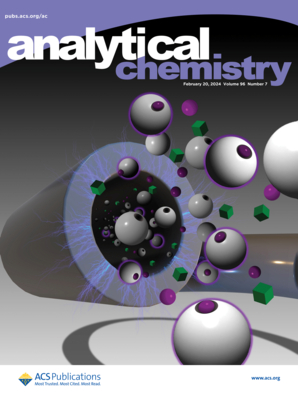Multilaboratory Untargeted Mass Spectrometry Metabolomics Collaboration to Identify Bottlenecks and Comprehensively Annotate A Single Dataset.
IF 6.7
1区 化学
Q1 CHEMISTRY, ANALYTICAL
引用次数: 0
Abstract
Annotation is the process of assigning features in mass spectrometry metabolomics data sets to putative chemical structures or "analytes." The purpose of this study was to identify challenges in the annotation of untargeted mass spectrometry metabolomics datasets and suggest strategies to overcome them. Toward this goal, we analyzed an extract of the plant ashwagandha (Withania somnifera) using liquid chromatography-mass spectrometry on two different platforms (an Orbitrap and Q-ToF) with various acquisition modes. The resulting 12 datasets were shared with ten teams that had established expertise in metabolomics data interpretation. Each team annotated at least one positive ion dataset using their own approaches. Eight teams selected the positive ion mode data-dependent acquisition (DDA) data collected on the Orbitrap platform, so the results reported for that dataset were chosen for an in-depth comparison. We compiled and cross-checked the annotations of this dataset from each laboratory to arrive at a "consensus annotation," which included 142 putative analytes, of which 13 were confirmed by comparison with standards. Each team only reported a subset (24 to 57%) of the analytes in the consensus list. Correct assignment of ion species (clusters and fragments) in MS spectra was a major bottleneck. In many cases, in-source redundant features were mistakenly considered to be independent analytes, causing annotation errors and resulting in overestimation of sample complexity. Our results suggest that better tools/approaches are needed to effectively assign feature identity, group related mass features, and query published spectral and taxonomic data when assigning putative analyte structures.多实验室非靶向质谱代谢组学合作,以确定瓶颈和全面注释单个数据集。
注释是将质谱代谢组学数据集中的特征分配给假定的化学结构或“分析物”的过程。本研究的目的是确定非靶向质谱代谢组学数据集注释中的挑战,并提出克服这些挑战的策略。为此,本研究采用液相色谱-质谱联用技术,在Orbitrap和Q-ToF两种不同采集方式的平台上,对一种叫Withania somnifera的植物的提取物进行了分析。由此产生的12个数据集与10个在代谢组学数据解释方面已建立专业知识的团队共享。每个小组使用他们自己的方法标注了至少一个正离子数据集。八个团队选择了在Orbitrap平台上收集的正离子模式数据依赖采集(DDA)数据,因此选择该数据集报告的结果进行深入比较。我们对来自每个实验室的数据集的注释进行了编译和交叉检查,以得出一个“共识注释”,其中包括142个假定的分析物,其中13个通过与标准的比较得到确认。每个团队只报告了共识列表中分析物的一个子集(24%到57%)。质谱中离子种类(簇和片段)的正确分配是一个主要的瓶颈。在很多情况下,源内冗余特征被错误地认为是独立的分析物,导致标注错误,导致样本复杂性的高估。我们的研究结果表明,在分配假定的分析物结构时,需要更好的工具/方法来有效地分配特征身份,分组相关的质量特征,并查询已发表的光谱和分类数据。
本文章由计算机程序翻译,如有差异,请以英文原文为准。
求助全文
约1分钟内获得全文
求助全文
来源期刊

Analytical Chemistry
化学-分析化学
CiteScore
12.10
自引率
12.20%
发文量
1949
审稿时长
1.4 months
期刊介绍:
Analytical Chemistry, a peer-reviewed research journal, focuses on disseminating new and original knowledge across all branches of analytical chemistry. Fundamental articles may explore general principles of chemical measurement science and need not directly address existing or potential analytical methodology. They can be entirely theoretical or report experimental results. Contributions may cover various phases of analytical operations, including sampling, bioanalysis, electrochemistry, mass spectrometry, microscale and nanoscale systems, environmental analysis, separations, spectroscopy, chemical reactions and selectivity, instrumentation, imaging, surface analysis, and data processing. Papers discussing known analytical methods should present a significant, original application of the method, a notable improvement, or results on an important analyte.
 求助内容:
求助内容: 应助结果提醒方式:
应助结果提醒方式:


